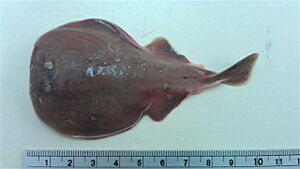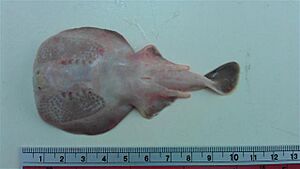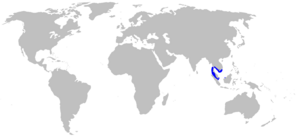Finless sleeper ray facts for kids
Quick facts for kids Finless sleeper ray |
|
|---|---|
 |
|
 |
|
| Conservation status | |
| Scientific classification | |
 |
|
| Range of the finless sleeper ray |
The finless sleeper ray (Temera hardwickii) is a special type of electric ray. It belongs to the Narkidae family and is the only member of its group, or genus. You can find this ray in the waters of Southeast Asia, from the eastern Andaman Sea all the way to Vietnam and Borneo.
This amazing ray is usually very small, growing to about 15 cm (5.9 in) long. It might even be the smallest cartilaginous fish in the world! What makes it truly unique is that it's the only electric ray without dorsal fins (the fins on its back). It has a flat, oval body and a short, strong tail with a deep caudal fin (tail fin). The shape of its pelvic fins (fins near its belly) is different for males and females.
Like other electric rays, the finless sleeper ray can create an electric shock. It uses this shock to protect itself from danger. This ray gives birth to live young, which grow inside the mother. The baby rays get their food from a yolk sac. Scientists have seen one mother ray with four babies. Sadly, the International Union for Conservation of Nature (IUCN) says the finless sleeper ray is a Vulnerable animal. This means it's at risk because it's caught by fishing nets, and it doesn't have many babies.
Contents
Discovering the Finless Sleeper Ray
The finless sleeper ray was first described in 1831 by an English zoologist named John Edward Gray. He wrote about it in a science magazine called Zoological Miscellany. Gray studied two rays that were collected in Penang, Malaysia, by General Thomas Hardwicke. That's why Gray named the ray Temera hardwickii, which means "Hardwicke's Temera."
Gray noticed that this new ray was very similar to another ray called Narke. The main difference was that Temera had no dorsal fins, while Narke had one. Most other electric rays have two dorsal fins. Later studies using the ray's body features also showed that Temera and Narke are closely related.
What Does the Finless Sleeper Ray Look Like?
The finless sleeper ray has a flat, oval body, which is called a pectoral fin disc. In adult rays, this disc is a bit wider than it is long. But in young rays, it can be round or longer than wide. Its small, round eyes are right next to its spiracles, which are openings that help it breathe.
Under the skin on each side of its head, you can see two kidney-shaped electric organs. These are what create the electric shock! The ray has small, round nostrils that are connected to its mouth by grooves. Its mouth is small and can stick out a bit. The teeth are flat and shaped like hexagons, arranged in narrow bands. It also has five pairs of short gill slits for breathing.
The pelvic fins are long and wide, shaped like triangles. In male rays, the back edges of these fins are more curved inwards than in females. The tail is thick and much shorter than the body disc. What's really special is that this ray has no dorsal fins at all, which is unique among electric rays. Its tail ends in a fairly large, triangular caudal fin (tail fin) with rounded corners.
The skin of the finless sleeper ray is completely smooth; it doesn't have any rough scales. It's usually light brown on top, sometimes with darker spots or whitish marks. Its belly is pale, and the edges of its pectoral and pelvic fins are darker. This ray is possibly the smallest cartilaginous fish. The smallest adult ever found was only 8.2 cm (3.2 in) long and weighed 13 g (0.46 oz). Most finless sleeper rays don't grow longer than 15 cm (5.9 in). The largest ever recorded was thought to be 18 cm (7.1 in).
Where Does It Live?
The finless sleeper ray lives in the eastern Andaman Sea, near the border between Thailand and Myanmar. Its home stretches through the Strait of Malacca to Singapore and north to Vietnam. There's also one record of this ray being found in Sarawak, Borneo.
This ray is a bottom-dwelling animal, meaning it lives on the seafloor. It prefers areas with fine sediment on the continental shelf, both close to shore and further out. In the 1800s, people said it was very common in the Straits of Malacca all year round. Today, it's still common in some places.
How Does It Live?
Electric Power!
The finless sleeper ray can create a medium-strength electric shock. It uses this shock to defend itself from predators. The shock comes from its two electric organs, which are about one-third the length of the ray. These organs are made of many columns filled with fluid. Each column acts like a tiny battery connected together.
This ray likely eats small invertebrates, which are animals without backbones. Its strong jaws suggest it might prefer to eat prey with hard shells.
Reproduction and Life Cycle
The finless sleeper ray has a special way of having babies called viviparous reproduction. This means the embryos (developing babies) grow inside the mother. They are fed by a yolk sac during their development.
Scientists once found a pregnant female ray that was 10.5 cm (4.1 in) long. She had four baby rays inside her, each about 2.9 cm (1.1 in) long. These baby rays looked and were colored just like the adults, but their bodies were thicker. Male finless sleeper rays become ready to have babies when they are about 8.2–10.9 cm (3.2–4.3 in) long. Females are ready when they are about 10.5–14.8 cm (4.1–5.8 in) long.
Protecting the Finless Sleeper Ray
The finless sleeper ray is often caught by fishing nets, especially bottom trawls, which drag along the seafloor. It can be caught as bycatch (unwanted fish caught while fishing for other species) in many fisheries across its range. Fishing is very active in the Andaman Sea, where these rays live.
Most rays caught are probably thrown back into the ocean. However, they often don't survive after being caught. Some finless sleeper rays caught by fishers in Myanmar are sold in Phuket, Thailand.
Because of the heavy fishing in its home waters and its low reproductive rate (it doesn't have many babies), the International Union for Conservation of Nature (IUCN) has listed the finless sleeper ray as Vulnerable. This means it's at high risk of becoming extinct. We don't have exact numbers for how many rays there are, but electric ray populations in general seem to have gone down since 1975, especially near Thailand.



